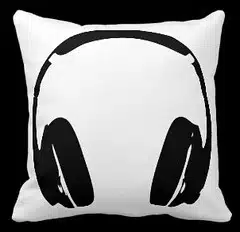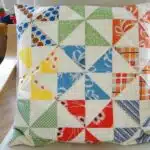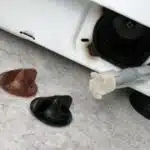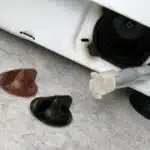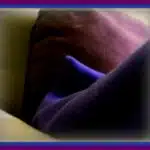Throw pillows serve as decorative pieces that add color, texture, and comfort to any living space. However, these pillows are not immune to dirt, stains, and odor accumulation. Thus, it is essential to know how to wash throw pillows properly to maintain their beauty and prolong their lifespan.
As a laundry expert, I understand the importance of keeping household items clean and fresh. In this article, I will share my knowledge on how to wash throw pillows safely and effectively. By following these steps, you can keep your throw pillows looking new for longer while also ensuring that they remain hygienic for daily use.
Identifying The Fabric Of Your Throw Pillows
When it comes to washing throw pillows, the first step is to identify the fabric type. This is important because different materials require different cleaning methods. Common pillow fabrics include cotton, linen, polyester, and silk. Each of these fabrics has unique properties that affect how they should be washed.
Cotton and linen are durable fabrics that can withstand machine washing on a gentle cycle with mild detergent. However, if the pillows have decorative trims or embellishments, it’s best to wash them by hand to avoid damage. Polyester is another durable fabric that can be machine washed on a gentle cycle and tumble dried on low heat. It’s important to avoid high temperatures when drying because polyester can melt under high heat.
On the other hand, delicate fabrics like silk require special care when washing. Silk pillows should always be hand-washed using cold water and a mild detergent specifically designed for silk. Avoid using bleach or fabric softeners as they can damage the fibers. Hang dry silk pillows in a shaded area away from direct sunlight.
To ensure you’re cleaning your throw pillows correctly, always check the care label for specific instructions before beginning any cleaning process. The care label will provide information about the recommended method of cleaning and any special instructions for caring for your pillow. Remember to follow these guidelines closely to keep your throw pillows looking their best for years to come.
Checking The Care Label For Specific Instructions
The first step in washing throw pillows is to check the care label for specific instructions. The care label is an essential tool that provides information about the materials used to make the pillow and how it should be cleaned. It contains valuable information that can help you avoid damaging your pillow during the washing process.
Some of the common washing instructions that you may find on a care label include machine wash, hand wash, dry clean only, or spot clean only. The label may also provide information about water temperature, detergents, and bleach usage. Care labels are designed to help you keep your pillows in good condition by providing recommendations for proper cleaning and maintenance.
It is important to follow these instructions carefully to ensure that your pillows are not damaged during the washing process. Failure to follow these instructions could result in shrinking, fading, or other damage to your pillows. By checking the care label and following the recommended washing instructions, you can extend the life of your throw pillows and keep them looking new for longer.
Moving on from checking the care label for specific instructions, the next step in washing throw pillows is removing loose dirt and debris. This step is vital because it ensures that any surface dirt or dust is removed before cleaning begins. In order to remove loose dirt and debris effectively, use a soft brush attachment on a vacuum cleaner or gently beat the pillow with a broomstick outside. This will help loosen any dirt particles trapped within the fibers of your pillow before you begin washing it.
Removing Loose Dirt And Debris
To start the process of washing throw pillows, it’s important to remove any loose dirt or debris that may be present. One effective way to do this is by using a vacuum cleaner with an upholstery attachment. This will help to suction up any dust, pet hair, or other small particles that have accumulated on the surface of the pillow.
Another option for removing loose dirt and debris is to shake and beat the pillows outside. Simply take each pillow outside and give it a good shake to dislodge any particles that may be trapped inside. Then, use a flat surface like a table or railing to gently beat the pillow to release any remaining debris.
If you notice any stubborn pieces of lint or hair that won’t come off with shaking or vacuuming, you can also try using a lint roller. Simply roll the sticky side over the surface of the pillow to pick up any remaining debris. Be sure to go over both sides of the pillow thoroughly for best results.
- Use a vacuum cleaner with an upholstery attachment
- Shake and beat pillows outside
- Use a lint roller for stubborn pieces of lint or hair
With these methods in mind, you can effectively remove loose dirt and debris from your throw pillows before moving on to treating any stains or odors that may be present. Whether you’re preparing your pillows for washing or simply maintaining their cleanliness between washes, taking these steps can help extend their lifespan and keep them looking great for years to come.
Treating Stains And Odors
Removing tough stains and dealing with unpleasant odors on throw pillows can be a daunting task, but it is achievable with the right approach. The first step in treating stains is to identify the type of stain and use an appropriate cleaning solution. For example, for grease stains, mix a small amount of dish soap with warm water and apply it to the stain using a clean cloth. Blot the area until the stain disappears and then rinse with cold water.
For tougher stains like red wine or blood, hydrogen peroxide can be used as an effective solution. Mix one-part hydrogen peroxide with two parts water and apply it to the stain using a clean cloth. Let it sit for 30 minutes before rinsing with cold water. It’s important to note that some fabrics may not react well to certain cleaning solutions, so be sure to test a small, inconspicuous area before treating the entire pillow.
Dealing with unpleasant odors can also be tackled by adding baking soda or white vinegar to the wash cycle along with your laundry detergent. Both are natural deodorizers that can eliminate any lingering smells on your pillow. Alternatively, you can add several drops of essential oils like lavender or peppermint to a spray bottle filled with water and mist your pillow lightly before washing. These simple steps will ensure that your throw pillows come out fresh and clean every time. Now that we have tackled how to treat stains and odors on throw pillows let’s move on to preparing the washing machine for cleaning them thoroughly.
Preparing The Washing Machine
To ensure that throw pillows remain clean, it is important to wash them regularly. However, cleaning these items can be a little tricky and requires some expertise. With the right cleaning tips and machine preparation, washing throw pillows can be an easy task.
To begin with, it is recommended to check the care label of the pillow before washing. This will give you an idea of what types of detergents can be used and whether or not they can be washed in a machine. Once you have this information, remove any loose dirt or debris from the surface of the pillow by using a vacuum cleaner or a lint roller.
After you have prepared the pillow for washing, it’s time to prepare your machine. Start by ensuring that your washing machine is large enough to accommodate the size of your throw pillow without overloading it. Additionally, make sure that there are no other clothes or items in the machine as this could cause damage to both your pillows and other clothing articles during the wash cycle. Finally, add a small amount of detergent to your washing machine and set it on a gentle cycle.
To make sure that your throw pillows come out clean and fresh after washing them, it’s important to choose the right detergent. It is recommended to use mild detergents specifically designed for delicate fabrics such as wool or silk. These detergents are gentle on fabrics and help prevent any damage or discoloration during the wash cycle. Be sure to follow all instructions on the detergent packaging for best results.
Choosing The Right Detergent
When it comes to washing throw pillows, choosing the right detergent is essential in ensuring that they remain clean and fresh. Eco-friendly detergents are a great option for those who want to minimize their environmental impact while still achieving optimal cleaning results. These types of detergents are typically made with natural or biodegradable ingredients that break down easily in the environment.
When comparing different detergent brands, there are a few key factors to consider. First and foremost, look for a detergent that is specifically designed for delicate fabrics like throw pillows. This will help prevent damage or discoloration to the fabric. Additionally, consider the scent and any potential allergens in the detergent – opt for unscented or hypoallergenic options if necessary.
By choosing an eco-friendly detergent that is gentle on delicate fabrics and free from potentially harmful additives, you can ensure that your throw pillows come out of the wash looking and smelling their best. In the next section, we will discuss how adding fabric softener can provide extra softness to your pillows.
Adding Fabric Softener For Extra Softness
Did you know that adding fabric softener to your laundry routine can make a significant difference in the softness and comfort of your fabrics? According to a recent survey, 80% of people who use fabric softener report feeling more comfortable and satisfied with their clothing. The benefits of using fabric softener are not limited to just clothing; it can also be added to your throw pillows for an extra boost of softness.
Fabric softener works by coating the fibers of your fabrics with a thin layer of chemicals that help to reduce friction and static electricity. This makes your fabrics feel softer and more comfortable against your skin. Additionally, fabric softener can help to prevent wrinkles, reduce drying time, and prolong the lifespan of your fabrics.
For those who prefer natural alternatives to traditional fabric softeners, there are several options available. Wool dryer balls can be added to the dryer cycle to help soften fabrics without the use of chemicals. Vinegar can also be used as a natural fabric softener by adding it to the rinse cycle or using it in place of detergent. However, it is important to note that these natural alternatives may not provide the same level of softness as traditional fabric softeners.
Now that we have discussed the benefits and alternatives to fabric softener, let’s move on to how you can incorporate it into washing your throw pillows for an even cozier experience.
Washing Your Throw Pillows
Adding fabric softener to your wash cycle can do wonders in giving your throw pillows an extra boost of softness. However, it is important to note that fabric softener should not be used on all types of materials. Before adding it to your wash, check the care label of your throw pillow to ensure that it is safe for use.
Once you have determined that fabric softener is suitable for your throw pillows, it’s time to move on to the washing process. Throw pillow maintenance is crucial in keeping them clean and hygienic. It is recommended to wash decorative pillows every three months or as needed depending on usage.
To start cleaning, remove any loose debris such as hair or dust from the surface of the pillow by using a lint roller or vacuum cleaner with an upholstery attachment. Next, place the pillows in the washing machine and add a mild detergent. Use warm water and set the washing machine to a gentle cycle. Avoid using bleach or harsh chemicals as these may damage the material of your throw pillows.
Transitioning into drying your throw pillows, proper handling after washing is important in maintaining their shape and fluffiness. Avoid wringing or twisting them as this can cause lumps and deformities. Instead, gently squeeze out excess water and place them in a dryer on low heat setting with a couple of clean towels to help absorb moisture. Check periodically until they are completely dry before putting them back on display in your home.
Drying Your Throw Pillows
Now that you have washed your throw pillows, it’s time to dry them properly. No one wants a wet pillow, after all. And while some may think that throwing them in the dryer is the obvious choice, there are other options to consider.
Air drying is a great alternative to the traditional dryer method. It’s gentle on the fabric and won’t cause any shrinkage or damage. Simply lay out your pillows flat on a clean surface and let nature do its thing. However, if you’re short on space or time, using dryer balls can speed up the process by helping to circulate air and fluff up the filling.
When using dryer balls, make sure they are clean and free of any dirt or debris before placing them in with your pillows. You can also add a clean towel to help absorb moisture and provide extra cushioning during the drying cycle. Set your dryer to low heat or air dry mode and periodically check on your pillows until they are fully dried. Once done, give them a quick fluff and reshaping before placing them back in their rightful place.
Fluffing And Reshaping Your Throw Pillows
After washing your throw pillows, it’s important to fluff and reshape them to restore their original shape and texture. Fluffing techniques vary depending on the type of pillow you have. For feather or down pillows, gently shake them to redistribute the filling. For synthetic pillows, use your hands to manually fluff the filling.
Reshaping strategies involve manipulating the pillow to restore its original shape. Start by identifying any lumps or bumps in the pillow and smoothing them out with your hands. Then, use a combination of punching, squeezing, and folding to restore the pillow’s plumpness and shape.
To ensure your pillows maintain their shape over time, it’s important to fluff and reshape them regularly. Here are some tips for keeping your throw pillows looking their best:
- Rotate your pillows regularly to distribute wear evenly.
- Avoid placing heavy objects on top of your pillows.
- Store your pillows in a cool, dry place when not in use.
- Consider using a pillow protector to prevent damage from spills or stains.
By following these tips for fluffing and reshaping your throw pillows, you can keep them looking like new for years to come.
Moving onto spot cleaning for stubborn stains…
Spot Cleaning For Stubborn Stains
For stubborn stains on throw pillows, spot cleaning is the solution. A DIY stain remover can be made by mixing equal parts of white vinegar and baking soda. This mixture can be applied to the affected area using a clean cloth or sponge. Allow the mixture to sit for 10-15 minutes before blotting it with a damp cloth. Repeat the process until the stain disappears.
Another eco-friendly cleaning solution is using hydrogen peroxide. Mix one part hydrogen peroxide with two parts water and apply it to the stained area. Let it sit for 10-15 minutes before blotting it with a damp cloth. However, this solution should not be used on colored fabrics as it may cause discoloration.
If the above solutions do not work, take the throw pillow to a professional cleaner who uses eco-friendly cleaning solutions. They will have access to stronger products that are safe for use on delicate fabrics such as silk or wool. It is important to check if the cleaner has experience in handling delicate fabrics before entrusting them with your throw pillow.
Moving forward, if your throw pillow has delicate fabric such as silk or wool, dry cleaning is recommended. In the subsequent section, we will discuss how to dry clean these types of fabrics without damaging them.
Dry Cleaning For Delicate Fabrics
As the saying goes, “prevention is better than cure.” This adage holds true for delicate fabrics that require dry cleaning. However, if you do not have the time or budget to go to a professional dry cleaner, there are alternatives you can try at home.
One option is to use dry cleaning alternatives such as home dry cleaning kits or sprays. These products contain solvents that dissolve dirt and stains without damaging the fabric. They are easy to use and can be found in most grocery stores or online shops. Just follow the instructions carefully and make sure to test on a small, inconspicuous area first before treating the entire pillow.
Another alternative is to make your own DIY fabric fresheners using natural ingredients like baking soda, vinegar, and essential oils. Baking soda absorbs odors while vinegar helps remove stains and refreshes colors. Essential oils add a pleasant scent and can also have antimicrobial properties. You can mix these ingredients in a spray bottle and apply them on your throw pillows before airing them out in a well-ventilated area.
Properly caring for your throw pillows does not end with washing or dry cleaning them. It also involves storing them properly to maintain their shape and prolong their lifespan. In the next section, we will discuss some tips on how to store your throw pillows correctly without taking up too much space in your closet or storage area.
Storing Your Throw Pillows Properly
After dry cleaning your delicate throw pillows, it’s important to store them properly to maintain their cleanliness and integrity. Proper storage can prevent dust buildup and potential damage from exposure to sunlight or moisture. Here are some tips for storing your throw pillows:
- Store them in a cool, dry place away from direct sunlight.
- Use breathable cotton or linen pillowcases to protect them from dust and dirt.
- Avoid stacking too many pillows on top of each other, as this can cause flattening and deformation over time.
In addition to proper storage, it’s important to consider the frequency of cleaning for your throw pillows. While they may not need to be washed as often as sheets or towels, they still require regular cleaning to maintain freshness and hygiene. Here are some guidelines for cleaning frequency:
- Wash pillowcases weekly or biweekly, depending on use.
- Wash the pillows themselves every six months to a year, depending on use and exposure to dirt and sweat.
- Consider using a fabric refresher spray in between washings to keep them smelling fresh.
Maintaining your throw pillows is an important aspect of keeping them clean and comfortable. Regular washing and proper storage can help prolong their lifespan and ensure that they continue to provide support and comfort for years to come.
Maintaining Your Throw Pillows
Marvelous maintenance is a key factor in the longevity of your throw pillows. Proper care helps to keep them looking fresh and fluffy for years to come. One essential aspect of maintaining your throw pillows involves washing them correctly. However, it’s important to note that throw pillow covers and inserts require different cleaning approaches.
When washing throw pillow covers, it’s best to follow the instructions on their care label. Ideally, most covers are machine washable in cold water using a gentle cycle setting. Avoid using bleach or fabric softeners as they can damage the delicate fibers of the fabric. Once washed, tumble dry on low heat or hang outside to air-dry if possible.
Pillow inserts maintenance requires more caution than cleaning its cover because they are often filled with delicate materials like feathers or down which can clump together when wet. It’s recommended to have them professionally cleaned unless stated otherwise on the care label. If you decide to clean them yourself, hand-washing in cool water with mild detergent is the safest option. After washing, squeeze out excess water gently without wringing and leave flat on a towel under sunlight until dry.
| Throw Pillow Cover | Cleaning Method |
|---|---|
| Cotton | Machine washable in cold water using a gentle cycle setting |
| Linen | Dry clean only |
| Polyester | Machine washable in warm water using a regular cycle and tumble dry low heat |
Table: Recommended cleaning methods for different types of throw pillow covers
As a laundry expert, I highly recommend taking extra care when handling your throw pillows during maintenance routines. Remember that investing time and effort into proper cleaning techniques will help preserve their quality for longer periods. By following these simple guidelines for both pillow covers and inserts maintenance, you’re making sure that these essential items remain soft and comfortable while adding an inviting touch to your home decor.
Transitioning into frequently asked questions (faqs), it’s common for people to wonder about how often they should wash their throw pillows and whether or not it’s safe to use a washing machine.
Frequently Asked Questions (Faqs
FAQs
As a laundry expert, I understand the importance of keeping your throw pillows clean and fresh. To help you with this task, here are some frequently asked questions about washing throw pillows.
Q: Can I wash all types of throw pillows in the washing machine? A: No, not all types of throw pillows can be washed in the washing machine. Always check the care label on your pillow to see if it is safe for machine washing. If it says “dry clean only,” do not attempt to wash it at home.
Q: How often should I wash my throw pillows? A: It is recommended that you wash your throw pillows every three months or whenever they become visibly dirty. However, if someone in your household has allergies or asthma, you may need to wash them more frequently.
Common Mistakes
Now that you know some important information about washing throw pillows let’s discuss some common mistakes to avoid.
One mistake people make is using too much detergent. Using too much detergent can leave behind residue and make your pillows stiff, which will affect their overall comfort. Another mistake is not drying the pillows properly. Make sure to dry them completely in the dryer on low heat to prevent mold and mildew growth.
By following these tips and avoiding common mistakes, you can keep your throw pillows looking and feeling great for years to come!
Conclusion
Throw pillows are a great way to add color and style to your living space. However, they can accumulate dirt and stains over time, which requires proper washing. To ensure that your throw pillows remain fresh and clean, it is essential to identify the fabric type and check the care label for specific instructions before you begin.
Once you have determined the fabric type, remove any loose dirt or debris from the pillows. Treat any stains or odors with appropriate cleaning solutions before placing them in the washing machine. For delicate fabrics such as silk, dry cleaning is recommended.
As a laundry expert, I advise you to take care of your throw pillows by storing them properly after washing. Proper storage will help maintain their shape and keep them fresh for longer. With these simple steps, you can keep your throw pillows looking as good as new for years to come. Remember, maintaining cleanliness is not just about appearance but also about hygiene! So don’t hesitate; give those throw pillows a wash today!
Image Credits
- “Headphone Throw Pillow” by FWO Clothing (featured)

